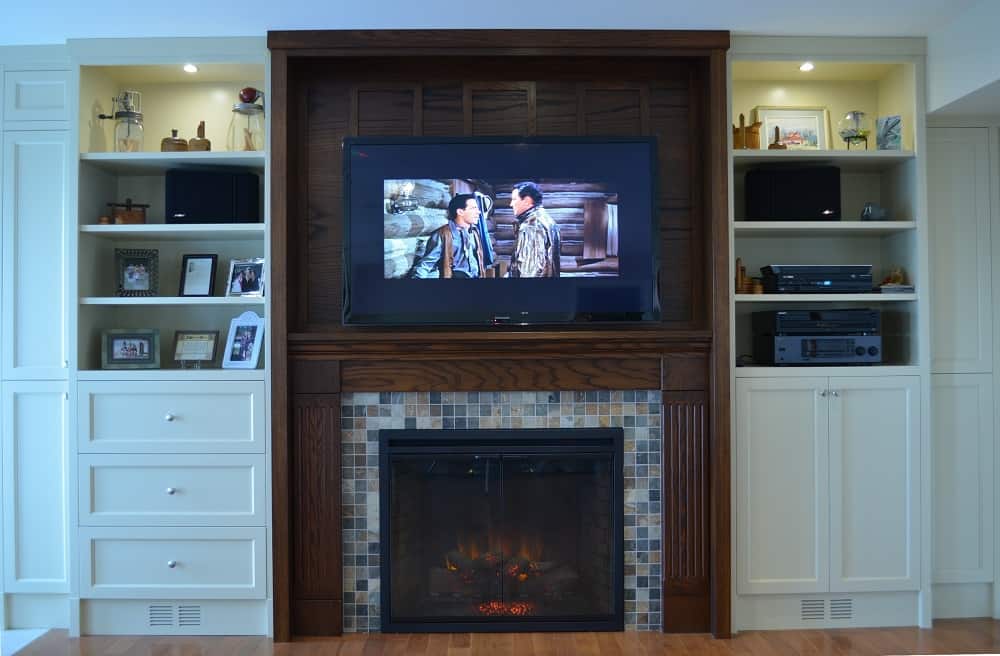Homeowners love fireplaces. According to a 2013 survey by the National Association of Realtors in the U.S., 40% of buyers said they would pay extra for a fireplace. Of realtors surveyed, 70% said a home’s value would increase if it had at least one fireplace. The National Center for Real Estate Research discovered that a home’s value would increase by about 12% for each fireplace. While our desire for a fireplace isn’t new, what that fireplace looks like, and how it operates, is changing. This has homeowners comparing wood fireplaces vs. gas fireplaces vs. electric fireplaces.
Everyone loves the smell and crackle of a wood fire, but many homeowners don’t want the mess or safety concerns that come with burning wood. In some areas, municipal governments are banning wood-burning fireplaces in order to improve air quality in the region. That leaves us with a choice of gas fireplaces vs. electric fireplaces when we’re building a new home or renovating an existing one.

Gas Fireplaces vs. Electric Fireplaces
Whether gas fireplaces are better than electric fireplaces is a raging debate, with many home builders offering gas models by default. However, a growing part of our business is the removal of gas fireplaces, to replace them with electric models. There’s a lot of misinformation and misunderstanding about gas fireplaces vs. electric fireplaces. Here’s what you need to know to compare them.
Realism
While some people claim that gas fireplaces have a ‘real’ flame, and are therefore superior to electric, it’s important to keep in mind that a gas fireplace has a forced flame around a man-made log or crystals, just as electric fireplaces do. If you look beyond the box stores, you will see that many electric fireplaces have flames that look as good or better than their gas counterparts. Leaders in the manufacture of electric fireplaces are also developing new technologies like Optimyst, from Dimplex, which turns tap water to a fine mist that is lit up by halogen bulbs to create a very real-looking flame effect.
Cost
Gas fireplaces cost more to purchase, install, and operate than electric fireplaces. Once installed, gas fireplaces will cost about $350 per year to run, vs. only $50 to $80 per year to run an electric fireplace. This surprises most people, because they understand that it is more cost-effective to heat their homes with gas rather than electricity. However, a gas fireplace isn’t nearly as efficient as a gas furnace. It takes a lot of fuel to create an attractive flame, and that fuel (i.e. natural gas) costs money. Compare that to an electric fireplace, where the flames are generated with LED lights and cost less than a penny per hour.
Heat
Gas and electric fireplaces both provide heat, but in varying amounts. A gas fireplace might have 25,000 – 30,000 BTU’s of heat available, or more, while an electric fireplace will have 3000 to 9000 BTU’s of heat available. Which one is best depends on how much heat you need. We equate 5000 BTU’s to be enough heat to take the chill off a space up to 400 square feet. That means that a gas fireplace with 25,000 BTUs could heat a space up to 2000 square feet, which may be your entire home. Unfortunately, that heat can’t reach the entire home, and will overheat the area in which it’s trapped. It may also trigger the thermostat on your furnace to turn off the heat in the rest of the house. Meanwhile, the flames on an electric fireplace may operate with or without the heater turned on. A blower circulates the heat into the room, whenever the heater is on. Electric models with a thermostat control will actually turn the heater on and off to maintain a constant temperature, without affecting the flames.
Efficiency
While you may equate gas furnaces with high-efficiency heating, the same cannot be said for gas fireplaces. As building codes mandate tighter, more energy-efficient construction, the need for supplemental heat sources, like fireplaces, is eliminated. Because electric fireplaces can run without the heater, they can provide the ambiance homeowners desire, without heat. Energy-efficiency guidelines also make it less desirable to break the building envelope to vent a fireplace. Up to 30% of the heat output of a gas fireplace may be lost through venting. Since no vent is required for an electric fireplace, (because nothing is burning), no heat is lost to the outdoors, and the building envelope remains intact.
Safety
Because they are burning fuel to create the flames, gas fireplaces generate heat that is transferred to the glass face. This glass gets hot enough to burn the skin on our hands. For this reason, the fireplace industry has mandated that a mesh safety barrier be placed on gas fireplaces, as of January 2015. On electric fireplaces, there is no fuel being burned to generate the flames, so the glass doesn’t get hot. Only the metal heat vent will get hot, but not to a temperature that will burn skin. As with any appliance that burns carbon fuels, there’s a risk of carbon monoxide leaks with gas fireplaces, so they must have routine maintenance to keep them operating safely.